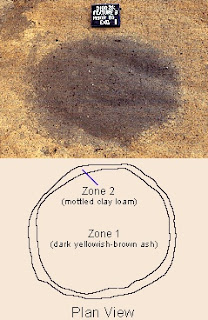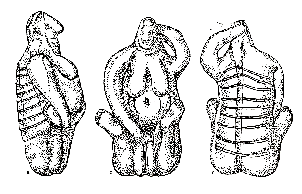There has been some feedback on the resignation of Mick Aston
from Time Team. Many people were concerned that Mick seems to think that his
time at TT and Bristol University was a waste of his time and they point out
quite forcefully that this is not so. They say that TT and Mick stimulated many
people to get involved in archaeology and that the subject has been changed, in
their eyes, from an arcane and exclusive discipline into an engaging one. Many
have been enrolling on courses to learn more about archaeology or joining and
even setting up societies so as to do work on and conserve their local
heritage. But some have pointed out that perhaps Mick has been naive about how
TV works. TV has to entertain and it has never been, primarily, an educational
tool. That naivety is stretched to its limit if one thinks, viewer and
participant, that the archaeologists run the show. The TV execs do that. Mick
must have realised that, after 20 years working in the medium. To quote one
letter to British Archaeology magazine “TV archaeologists like the living and
hope that the ‘truth’ makes it through”. In other words they take the money and
try their best to do a decent job, but they still take the money!
On TT generally people seem very concerned that the only archaeology
programme on TV is ‘dumbing down’, there is less rigour in regards to having
the archaeology at its centre and a possible “slide into the abyss of
trendiness”. Why try to mend something that is not broken? Some have seen a
possible conspiracy by the TV execs to dump the show by constantly changing the
schedule and that they are obsessed by presentation and not content (the focus
turning to presenters not subject) so that the numbers of viewers declines and
that leads to cancellation. One made a political point, in that this is based
on the general system of market commodities and selling, the cult of
personality and celebrity and the cutting of heritage funds.
When Time Team was set up it was based on the appeal of the
subject for TV and, most importantly, getting the right people involved in
making the programme who loved archaeology and worked in it. Archaeology is
about research, practical discovery and developing a story of peoples lives
based on the artefacts they used and the features in the landscape they
created. The TV people could see that this would work if they could minimize
the days of finding nothing and maximising the human story based on lots of
‘treasure’. However, TV people are in the creation/creative business. They are
constantly looking to change and develop their ‘product’, to ‘refresh the
brand’. ‘What do the public want?’ ‘How is the public taste changing and can we
mould it?’ Archaeologists know that cultures and society change and observe it
changing over time, but TV people want to
change it, to increase audience figures and make more money. They do this
by not giving what the public wants, but by giving them what they think it
wants. For nearly 20 years Channel 4 took a hands-off approach to TT and the
format changed very little. Something had to give. Bring in the trendy, out
with the wrinklys. It is not change that is wrong, it is how the change is
made. They tried to leave the ‘bones’ of the show intact and dress it in other
clothes. This had very little to do with a falling out between individuals, as
Mick Aston had left before Ochota was not rehired after one series. They just
got it wrong and the guano hit the fan.
I agree with the opinion that TT has had its day (or rather
decades). A new format needs to be devised to build on the foundations set by
TT so that archaeology develops and maintains its profile in the media and
builds more public support for heritage research generally.
At the heart of any new programme should be a team of TV and
archaeology professionals, as at TT. But, to use ugly terms in vogue at the
moment, archaeologists should be the drivers
and TV technicians/producers the enablers.
The role of the media is to get the information out there and to construct a
product that people will buy. People are investing their time and they will not
watch if the programme design is dull. I had many a dull hour listening to bad
teachers at university talking about a subject I love. Make a bad
programme/lecture and people/students will not listen. The role of the
archaeologists is to deliver the story of the human struggle to survive, to
create and to destroy since first we left Africa. That is a story worth
telling; an exciting story. But it must be based on the small, not just the
large. By that I mean most of us have memories of being taught in school and
having dates of battles and kings/queens banged into our heads. Even at ‘A’
Level I had to do the French Third Republic, the Russian Revolution and Europe
Between the Wars. All great stuff but massive subjects. I grew up in south
Essex and was pleased to leave. But I am currently writing a book on the
archaeology of the area because it is the place where I have memories and
roots. Most people feel that way about their village, city or county and are fascinated
with its past. It’s personal. This should be at the heart of any new programme.
Of course, people will still be interested in the ‘sexy’ big sites. But even
very local sites can tell a great story, not just for the people of the area
but also the nation. Many programmes can be thus made which would attract
viewers, especially if local people could be involved too. Look at the Michael
Wood programmes last year. Because that is the ‘third estate’ missing in archaeology
– the public. For goodness sake, it’s their
heritage.
Now I come to one point that bugs me. I have read that any
programme should get the ‘best’ archaeologists. What criteria are we using
here? I was taught by some of the best archaeologists at UCL, but some of them
were lousy teachers. I have worked with some of the best field archaeologists
and some of them could not string a sentence together or look you in the eye.
At the moment TT shows us that TV looks for ‘boffins’, directors, managers
(pretending to be diggers to get on TV) eccentrics and pretty faces, with
diggers seen, if at all, just from behind (not always their best feature). Does
anyone really look to diggers when thinking about who can articulate the
information that a site produces? Anyone who has dug knows that archaeology is
a team business and we all have different skills and abilities. Let’s use them
more democratically. We need ‘faces’ that know what they are talking about and how
to tell it. Let’s be honest; this includes people who are engaging and look
right too. In TV you have to have an image. That’s the way it works. If Mick
did not care how he looked why did he wear that jumper for 20 years? Why is
Phil always in that sweaty hat? Because some TV person picked up on it from the
start and asked them to carry on wearing them because it looked right.
I really hope that someone will put together a programme that
shows how archaeology and the deeper past can be exciting, engaging, entertaining
and relevant to people of the 21st century and for generations to come.
Agree or disagree - leave a comment.

















